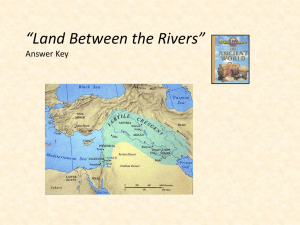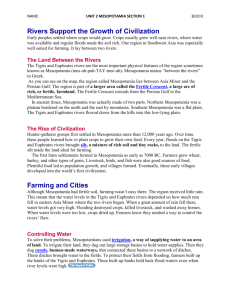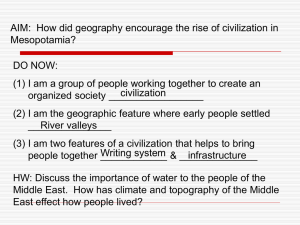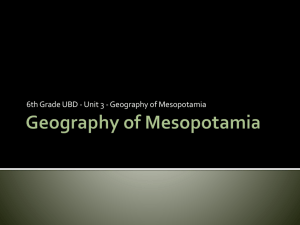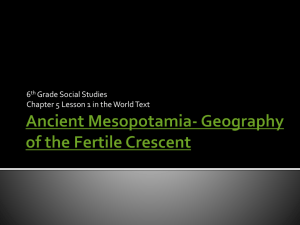Mesopotamia
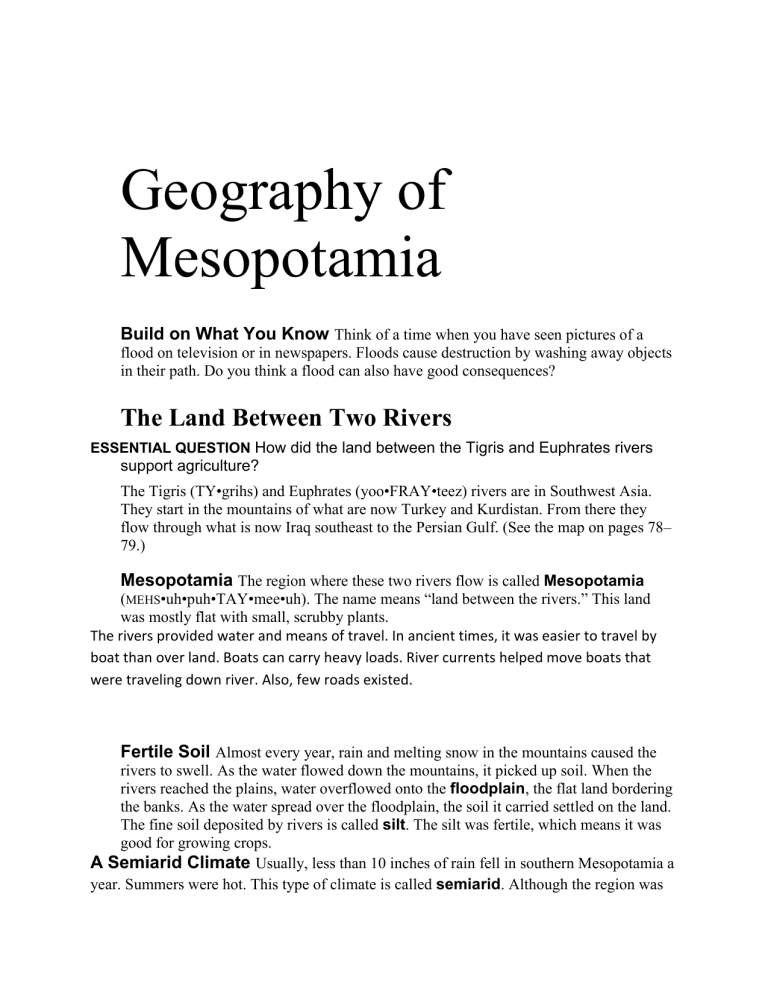
Geography of
Mesopotamia
Build on What You Know
Think of a time when you have seen pictures of a flood on television or in newspapers. Floods cause destruction by washing away objects in their path. Do you think a flood can also have good consequences?
The Land Between Two Rivers
ESSENTIAL QUESTION How did the land between the Tigris and Euphrates rivers support agriculture?
The Tigris (TY•grihs) and Euphrates (yoo•FRAY•teez) rivers are in Southwest Asia.
They start in the mountains of what are now Turkey and Kurdistan. From there they flow through what is now Iraq southeast to the Persian Gulf. (See the map on pages 78–
79.)
Mesopotamia
The region where these two rivers flow is called Mesopotamia
( MEHS
•uh•puh•TAY•mee•uh). The name means “land between the rivers.” This land was mostly flat with small, scrubby plants.
The rivers provided water and means of travel. In ancient times, it was easier to travel by boat than over land. Boats can carry heavy loads. River currents helped move boats that were traveling down river. Also, few roads existed.
Fertile Soil
Almost every year, rain and melting snow in the mountains caused the rivers to swell. As the water flowed down the mountains, it picked up soil. When the rivers reached the plains, water overflowed onto the floodplain , the flat land bordering the banks. As the water spread over the floodplain, the soil it carried settled on the land.
The fine soil deposited by rivers is called silt . The silt was fertile, which means it was good for growing crops.
A Semiarid Climate
Usually, less than 10 inches of rain fell in southern Mesopotamia a year. Summers were hot. This type of climate is called semiarid . Although the region was
dry, ancient people could still grow crops because of the rivers and the fertile soil. Farming villages were widespread across southern Mesopotamia by 4000 B.C.
Controlling Water by Irrigation
ESSENTIAL QUESTION How did the climate affect farmers?
Being a farmer is difficult. Crops need the right amount of water to thrive. The floods and the semiarid climate in Mesopotamia meant that farmers often had either too much water or too little.
Ancient Irrigation
The model below shows how an ancient irrigation system worked.
1 Gates controlled how much water flowed from the river.
2 Main canals led from the river. They sloped gently downward to keep the water flowing.
3 Medium-sized branch canals led away from the main canals.
4 Small feeder canals led water directly to the fields.
Floods and Droughts
The yearly flood was unpredictable. No one knew when the flood would occur. It might come in April or as late as June. Farmers could not predict when to plant. Also, the flood’s size depended on how much snow melted in the mountains in spring and how much rain fell. If there was too much, the flood might be violent and wash everything away. If there was too little rain and melting snow, the flood would not come.
A drought is a period when not enough rain and snow fall. In a semiarid region, drought is a constant danger. During a drought, the river level would drop, making it hard to water crops. If crops failed, people starved.
Irrigation
By about 6000 B .
C ., farmers built canals to carry water from the rivers to their fields. Such a system is called irrigation. Often, the silt in the water clogged the canals.
Workers had to clean out the silt to keep the water flowing. They also built dams to hold back excess water during floods.
Finding Resources
ESSENTIAL QUESTION How did Mesopotamians cope with a lack of resources?
Since the beginning of time, humans have had to solve problems in the environment.
For example, Mesopotamia had no forests to provide wood. The region also lacked stone and minerals, such as metals.
Mud Houses and Walls
Because of that lack of resources, Mesopotamians had few building materials. Since they could not build with wood or stone, they used mud for bricks and plaster. However, mud buildings crumbled easily and had to be repaired often.
Also, Mesopotamia was easy to invade because it had few mountains or other natural barriers. As a result, people from other regions often came to steal from the Mesopotamians or conquer them. The ancient Mesopotamians wanted to protect themselves, but they had no trees or stone to build barriers. So people built mud walls around their villages.
Finding Resources
Mesopotamians obtained some stone, wood, and metal outside their own land. They were able to trade for these things because they grew a surplus of grain. Surplus means more than they needed for themselves.
Jobs such as digging canals, building walls, and trading had to be done over and over. Community leaders began to organize groups of people to do the work at the right time. Lesson 2 explains more about the organization of society.
Why was trade important in Mesopotamia?
Lesson Summary
• The Tigris and Euphrates rivers made the soil of Mesopotamia good for growing crops.
• The people of Mesopotamia developed an irrigation system to bring water to crops.
• Mesopotamia had few resources. People traded surplus crops to get what they needed.
Why It Matters Now . . .
The Mesopotamians had to overcome a lack of resources. Today people still work to solve shortages of water, food, and resources.

